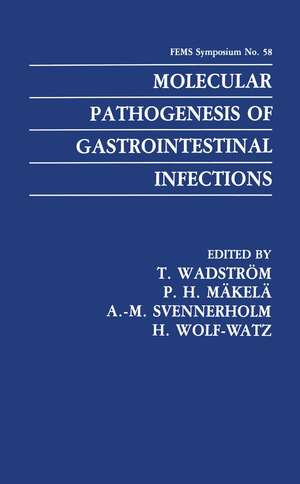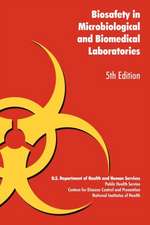Molecular Pathogenesis of Gastrointestinal Infections: F.E.M.S. Symposium Series, cartea 58
Editat de T. Wadström, P. Helena Mäkelä, A.M. Svennerholm, H. Wolf-Watzen Limba Engleză Paperback – 3 mar 2013
Preț: 376.95 lei
Preț vechi: 396.78 lei
-5% Nou
Puncte Express: 565
Preț estimativ în valută:
72.15€ • 75.04$ • 60.46£
72.15€ • 75.04$ • 60.46£
Carte tipărită la comandă
Livrare economică 13-27 martie
Preluare comenzi: 021 569.72.76
Specificații
ISBN-13: 9781468459845
ISBN-10: 1468459848
Pagini: 356
Ilustrații: X, 342 p. 67 illus.
Dimensiuni: 178 x 254 x 19 mm
Greutate: 0.62 kg
Ediția:1991
Editura: Springer Us
Colecția Springer
Seria F.E.M.S. Symposium Series
Locul publicării:New York, NY, United States
ISBN-10: 1468459848
Pagini: 356
Ilustrații: X, 342 p. 67 illus.
Dimensiuni: 178 x 254 x 19 mm
Greutate: 0.62 kg
Ediția:1991
Editura: Springer Us
Colecția Springer
Seria F.E.M.S. Symposium Series
Locul publicării:New York, NY, United States
Public țintă
ResearchCuprins
The Mucosal Surface.- The Enterocyte and Its Brush Border.- Characteristics of the Recognition of Host Cell Carbohydrates by Viruses and Bacteriac.- Structure and Properties of Rat Gastrointestinal Mucins.- The Role of Large Intestine Mucus in Colonization of the Mouse Large Intestine by Escherichia coli F-18 and Salmonella typhimurium.- Germfree Animals Intestinal Glycoconjugates and Colonization.- Bacterial Glycosidases and Degradation of Glycoconjugates in the Human Gut.- The Parasite.- The Clone Concept and Enteropathogenic Escherichia coli (EPEC).- Genetics of Histone-Like Protein H-NS/H1 and Regulation of Virulence Determinants in Enterobacteria.- Regulation of Expression of Fimbriae of Human Enterotoxigenic Escherichia coli.- Function and Molecular Architecture of Escherichia coli Adhesins.- Newly Characterized Putative Colonization Factors of Human Enterotoxigenic Escherichia coli.- Molecular Biology of Escherichia coli Type 1 Fimbriae.- Intestinal Colonization by Enteropathogenic Escherichia coli.- Diffuse Adherence of Enteropathogenic Escherichia coli Strains.- Enterotoxigenic Organisms.- Intracellular Mechanisms Regulating Intestinal Secretion.- Cholera Toxin: Assembly, Secretion and In Vivo Expression.- Heat-Stable Enterotoxins Produced by Enteric Bacteria.- Molecular Analysis of Potential Adhesions of Vibrio cholerae 01.- Shigella Toxin and Related Proteins — Translocation to the Cytosol and Mechanism of Action.- Vero Cytotoxins (Shiga-Like Toxins) of Escherichia coli.- Structure and Function of Clostridium difficile Toxins.- On the Cytotoxic Modes of Action of Clostridium difficile Toxins.- Invasive Organisms.- Salmonella as An Invasive Enteric Pathogen.- Experimental Salmonellosis in Retrospect and Prospect: 1990.- Colonization of the MurineGastrointestinal Tract by Salmonella typhimurium.- Plasmid Encoded Virulence of Yersinia.- Interactions of Yersinia with Collagen.- Thermoregulation of Invasion Genes in Shigella flexneri Through the Transcriptional Activation of the virB Gene on the Large Plasmid.- Association of Invasive Shigella Strains with Epithelial Cells.- Haemagglutinating Shigellae.- Molecular Pathogenesis of Giardia lamblia: Adherence and Encystation.- The Pathogenic Mechanisms of Helicobacter pylori — A Short Overview.- Superficial Components of Helicobacter pylori, in Relation to Adherence to Epithelial Cells.- Polymerase Chain Reaction and Other DNA Based Diagnostics of Enteric Infections.- Detection of Virulence Determinants in Enteric Escherichia coli Using Nucleic Acid Probes and Polymerase Chain Reaction.- DNA Probes and PCR Analysis in the Detection of Clostridium difficile and Helicobacter pylori.- Vaccine Development.- The Development of Genetically Defined Live Bacterial Vaccines.- Development of an Oral Vaccine Against Enterotoxigenic Escherichia coli Diarrhea.- Poster Session.- Comparison of Virulence Factors in Different Freshly Isolated Strains of Entmaoeba histolytica.- A System for Production and Rapid Purification of Large Amounts of the Shiga Toxin/Shiga-Like Toxin B Subunit.- Expression and Possible Biological Functions of Curli on Infantile Diarrhoea Escherichi coli Isolates.- Studies on Heat-Stable Enterotoxin Type II (STII or STb) from Escherichia coli.- Immune Response to Vibrio cholerae Infection in Rabbits with Special Reference to Antibodies Against In Vivo Specific Antigens.- Expression of Type 1 Fimbriae by Escherichia coli F18 in the Streptomycin-Treated Mouse Large Intestine.- Flagellar Components of Helicobacter pylori.- The Influence of Intestinal Mucus onPlasmid Encoded Adhesion and Surface Hydrophobicity of Yersinia enterocolitica.- The Binding of Bacteria Carrying CFAs and Putative CFAs to Rabbit Intestinal Brush Border Membranes.- Factors Contributing to the Persistence of Escherichia coli in the Human Large Intestinal Microflora.- The Role of Piglet Intestinal Mucus in the Pathogenicity of Escherichia coli K88.















